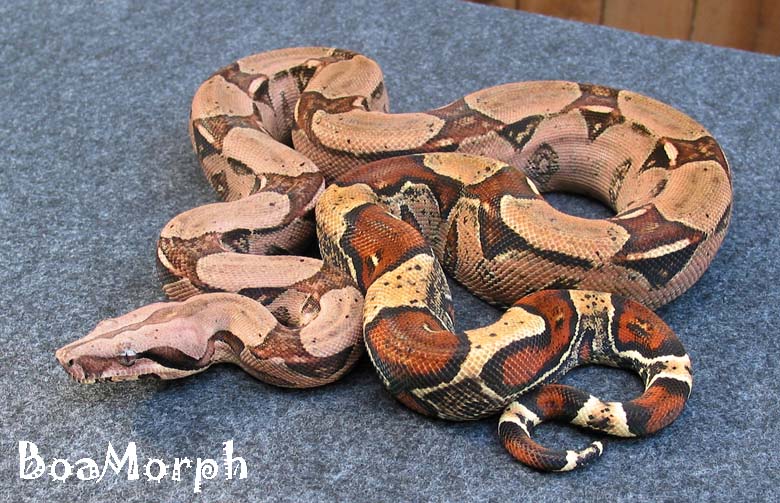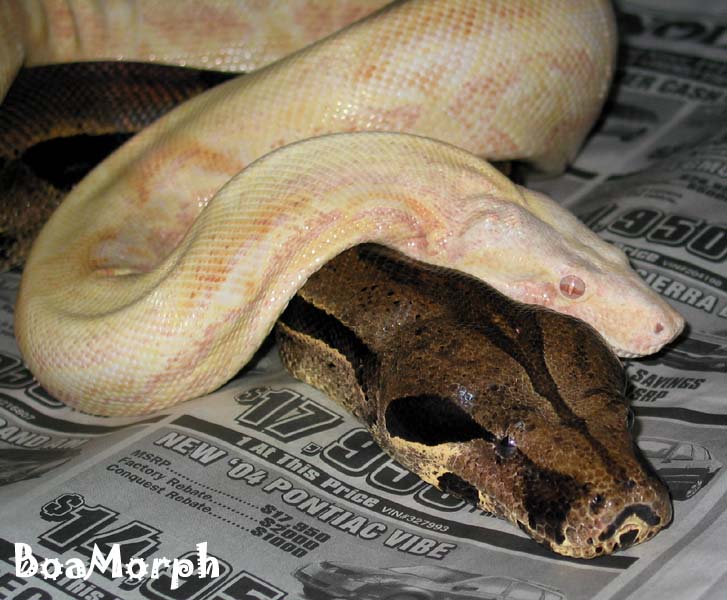|
The nature of the coral trait has not yet been proven; that is to say, the
genetic mechanism by which the coral trait is passed from parent to offspring has not yet been identified. All of the usual suspects from simple recessive to dominant/co-dominant to good old selective breeding
have been postulated, but the bottom line is that nobody knows yet. There are a number of reasons why the identification of
the mechanism for inheritance of the coral trait has been problematic.

|
| Groovy Girl |
First, the expression of the coral trait in albinos
is highly variable and it is difficult to define exactly what "coral" is. Breeding
trials of coral albino to coral albino by other breeders have produced litters from which all of the individuals were
considered to be coral albinos, but which varied in their expression of the coral trait from coral albinos that looked more
like Groovy Girl in the photo at right, to coral albinos that looked more like Groovy's Sister in the photo below.

|
| Groovy's Sister |
So what is "coral"? What is it that makes a coral albino a coral albino? It
is easy to identify and accept that Groovy Girl is a coral albino, but what about Groovy’s Sister? There are many
albinos that develop "coraling" to varying degrees, but how is one to tell if a particular boa is a true coral albino? Is
the deep pink/red head a definitive characteristic for this trait? What about those that just have a dusting or a few speckles
of red on their heads? Is there any specific, consistently visually-identifiable characteristic that distinguishes an albino
from a coral albino? In a word, no. There
are parallels that can be drawn with other genetic color and pattern traits, but simply put, it appears that one can have
a coral albino boa that does not look very "coral," yet an albino boa that looks a bit “coral” is not necessarily
a coral albino. Because of the variability in expression of the coral trait, it is difficult based only on visual appearance
to know if a particular boa is a true coral albino or not.
Furthermore, the question of the occurrence and expression of the coral trait
in het albino or normal boas adds to the uncertainty about the coral trait (in genetics terminology, normal is “wild
type” or “wt”, which in this instance specifically means not albino and not het albino). If a coral albino
boa is bred to a wt boa, all of the offspring are 100% het albino. But are they het coral albino? Are they het albino and
het coral? Are they het albino possible het coral? Are there heterozygous and homozygous forms of the coral trait, and if
so are they visually distinguishable? Are heterozygous and homozygous even the
proper genetic terms as they relate to the coral trait? Can wt boas (again here, specifically not albino and not het albino)
possess and express the coral trait? To the best of our knowledge, there are currently no scientifically supported answers
to any of these questions. Quite simply, nobody knows! The following two boas are littermates whose parents are what we consider
to be a weakly-expressed (or “low-expression”) coral albino male (Big Daddy) and an average-colored het albino
possible coral female (Big Mama). What do you think?

|
| A High-expression Coral Albino Born New Year's Day 2004 |

|
| A Het Albino Possible Coral from the Same January 1, 2004 Litter |

|
| A Close-up of the Boa Above |
Is it coral expression in this het albino boa, or just good coloration? If one was able to peel away his black pigment, would he be left a coral albino like
his brother?
Big
Mama and Big Daddy are pictured again in the photograph below; they are the parents of ALL of the other boas shown above.

|
| Big Daddy and Big Mama |
As you can see, even when
he is looking his best Big Daddy does not have the deep pink/red head nor the intense coloration of Groovy Girl or the other
high-expression coral albino pictured above. Big Mama, though a het albino and possible coral, does not exhibit the impressive
coloration of her het albino offspring pictured above. Yet, this pair produced
all three of the coral albinos and the het albino pictured above. Thus far, the issue of inheritance and expression of the
coral trait in het albino and wt boas has provided more questions than answers. There is much to be learned here!

|
| Groovy Girl looked similar to this littermate at eight months old. |
Finally, one of the most confounding
factors in evaluating the nature of the coral trait is that it can remain completely unexpressed for at least 12 to 18 months!
Although the photo at right is actually of one of her littermates, Groovy Girl looked very similar to this at age 8 months.
At that time we had taken photos of only a few boas from this litter because they all looked so similar, and no pictures
of Groovy Girl were taken then because she was the least attractive of them all!
Sure glad we chose to hold
onto that late bloomer! Based on our observations, it appears that there may also be a size component related to coral
expression. A small number of the het albino possible corals that we held back and that were grown more slowly than others
did not begin to show evidence of the coral trait until they were well over two years old!
Most breeders do not have the time, space, money or patience to keep and raise an entire litter of boas for as long
as two years to see if and how the coral trait will be expressed in each and every animal in the litter. Unless entire litters
are evaluated through maturity, it is impossible to accumulate accurate statistical data on the nature of transmission of
the trait – and this would be true even if the coral trait were an easily‑identifiable consistently‑expressed
visual trait!
|

